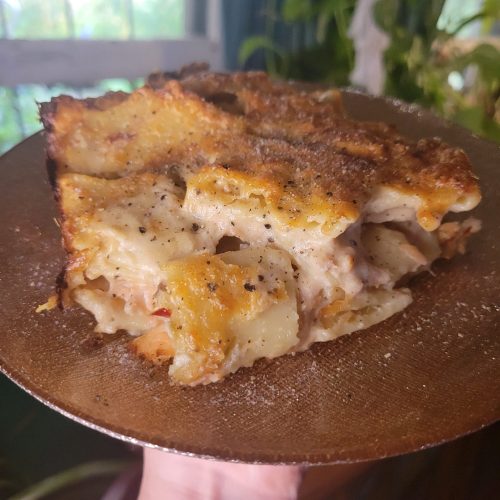
Macaroni & Cheese w/ Salmon & Fresno Chilis
This Salmon Macaroni & Cheese consists of butter, flour, mustard powder, Worcestershire sauce, wine, Greek yogurt, Fresno chilis, and parmesan cheese.
Equipment
- Large Baking Dish
- Oven
- Large Pot
- Skillet
- Stovetop
Ingredients
- 1 lbs. salmon
- 1 lbs. macaroni I used jumbo penne in this recipe
- 1/4 c. butter
- 1/4 c. all-purpose flour
- 1/2 tsp. salt
- 1/2 tsp. pepper
- 1 tsp. mustard
- 1 tsp. Worcestershire sauce
- 2 Fresno chili peppers (or Serranos), minced
- 1 ½ c. Greek yogurt
- 1/4 c. dry white wine (I used sauvignon blanc)
- 2⅓ c. Parmesan cheese (divided 2 c. + 1/3 c.), grated
Instructions
Bake Salmon
- Preheat oven to 450 degrees Fahrenheit.
- Place salmon skin-side down on a griddle. Drizzle with olive oil and add a dash of salt and pepper. Slice a lemon and place evenly on top of the salmon.
- Bake salmon for 12-15 minutes, or until the salmon begins to flake. Salmon tends to be cooked when it loses the bright color and you can take a fork and it easily separates. Larger cuts of salmon may take upwards of 20 minutes. Smaller, individual portions may take less time. It's best to begin checking after 10 minutes of cooking and adjust the cooking time to the doneness of your filet.
Cook Pasta
- Add about 4 inches of water to a large pot and bring to a boil over high heat.
- Cook pasta according to the manufacturer's instructions. This typically entails boiling for about 8-12 minutes, or until barely al dente.
- The pasta will cook another half hour in the oven, so make sure not to overcook them during this stage!
- DO NOT DRAIN. Remove the pasta from the water with a slotted spoon or pour the water into a heat-safe bowl. Since Greek yogurt isn't as thin as milk or cream in classic macaroni and cheese recipes, you will need to cut it with the pasta water. Tap water will not taste the same. You want to use the water that the pasta has been boiling in.
- You may want to stir it occasionally to keep the noodles from sticking together.
Prepare Roux
- Preheat the oven to 350 degrees Fahrenheit.
- Lightly coat the bottom and sides of a large baking dish with olive oil and set aside.
- Preheat saucepan on medium-heat. Add 1/4 cup butter and melt.
- Immediately when the butter melts, add flour and stir constantly until incorporated. This should take about 3 minutes.
- Do NOT brown or overcook, though. You just want the butter and flour to incorporate until you add the spices.
- Add salt, pepper, mustard, and Worcestershire sauce. Stir constantly for 5 minutes, or until lightly browned.
- Add Greek yogurt, a little at a time, and stir constantly until incorporated after each addition. Adding too much at once can cause the roux to separate. Although this is less of an issue with yogurt as it is milk or cream, it is still something to watch out for!
- Meanwhile, grate the cheddar cheese and add to roux 1/2 cup at a time. Mix constantly until fully incorporated.
- Add just enough of the dry white wine to thin out the sauce. I typically use about 1/4 to 1/2 cup. Although it does vary slightly from batch to batch.You want the sauce to be about the consistency of an Alfredo sauce. It should spread easily, but is not a liquid. I would suggest airing on the side of caution and adding less, mixing the pasta in, and then adding more if necessary for it to achieve the quintessential macaroni and cheese texture.You can also use pasta water instead of or in addition to wine.
- Add noodles, spinach, and peppers. Stir until fully coated in the cheese sauce.
- If necessary, add more water to achieve the right consistency.
Bake Macaroni & Cheese
- Pour macaroni and cheese into greased baking dish.
- Grate 1/3 cup cheese over the top.
- Bake for 30-40 minutes, or until the top begins to brown.
- Let cool slightly and cut into 2-inch squares. Serve immediately.
Tips, Tricks, & Notes
- You can reheat macaroni in the oven at 350 degrees for about 15 minutes. However, macaroni and cheese doesn't necessarily reheat well! After refrigeration, the noodles typically harden and the lasagna tends to dry out. The pasta will likely overcook during this process. And the cheese tends to separate and get oily if you reheat too rapidly.
- Whatever you do, absolutely do not put macaroni and cheese in the microwave!!
- Alternatively, you can reheat on the stovetop. Just place in a skillet with a lid and slowly bring the heat to medium. When the macaroni begins to soften, carefully spear with a silicone spatula to separate. Continue to heat with the lid on and stir occasionally. You may need to add additional milk or Greek yogurt to this to help prevent the noodles from drying out and the cheese from separating.